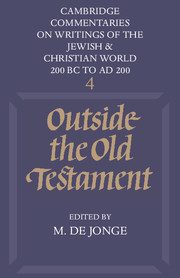Book contents
- Frontmatter
- Contents
- General Editors' Preface
- Editor's Foreword
- Acknowledgements
- Abbreviations
- General Introduction
- Pseudo-Philo, Liber Antiquitatum Biblicarum
- The Ethiopic Book of Enoch
- The Testament of Abraham
- The Testaments of the Twelve Patriarchs
- Joseph and Aseneth
- The Book of Jubilees
- The Testament (Assumption) of Moses
- The Psalms of Solomon
- The Martyrdom of Isaiah
- The Syriac Apocalypse of Baruch
- Paraleipomena Jeremiou
- The Testament of Job
- Index
The Book of Jubilees
Published online by Cambridge University Press: 05 June 2012
- Frontmatter
- Contents
- General Editors' Preface
- Editor's Foreword
- Acknowledgements
- Abbreviations
- General Introduction
- Pseudo-Philo, Liber Antiquitatum Biblicarum
- The Ethiopic Book of Enoch
- The Testament of Abraham
- The Testaments of the Twelve Patriarchs
- Joseph and Aseneth
- The Book of Jubilees
- The Testament (Assumption) of Moses
- The Psalms of Solomon
- The Martyrdom of Isaiah
- The Syriac Apocalypse of Baruch
- Paraleipomena Jeremiou
- The Testament of Job
- Index
Summary
The Book of Jubilees is a narrative work which presents a strongly edited version of most of the biblical material from the story of creation to the account of the Law-giving on Mt Sinai. It claims to be the written form of the revelation which God, through an angel of the presence, granted to Moses on that mountain.
Titles
Ancient writers used several titles for Jubilees, the most frequently attested of which are the following three. (1) The Book of the Divisions of the Times: this name derives from the opening words of the text and aptly captures the author's penchant for dating events according to his peculiar chronological system. The title is found in one of the Qumran Scrolls (the Damascus Document (CD) xvi.3) and, in the abbreviated form The Book of the Divisions (or just Divisions), remains the standard designation for it in Ethiopia (2) The Book of Jubilees: the familiar English title is a transcription of a name which, with minor variations in spelling, appears in some Greek, Syriac and Mediaeval Hebrew references to the book. A jubilee, which the author understood as a 49-year period, serves as the major chronological unit in his calculation of dates. (3) The Little Genesis: a number of early Christian writers and, later some Byzantine chronographers referred to Jubilees under this title. It highlights the obvious relationship of the book to Genesis but why the adjective little was added is not clear.
- Type
- Chapter
- Information
- Outside the Old Testament , pp. 111 - 144Publisher: Cambridge University PressPrint publication year: 1986



